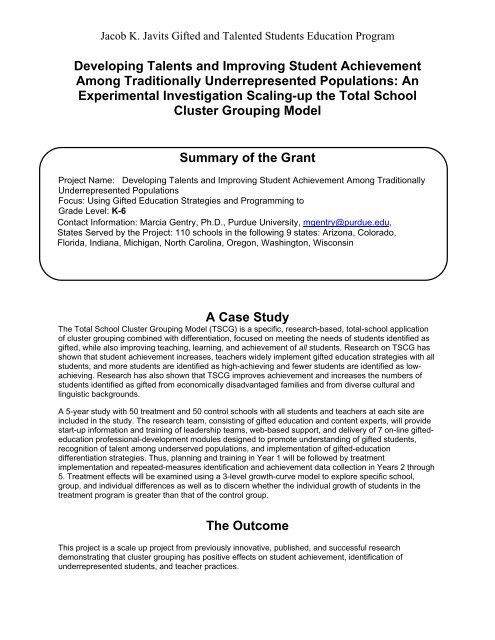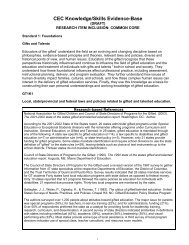Advanced Readers At Risk: Rescuing an Underserved ... - NAGC
Advanced Readers At Risk: Rescuing an Underserved ... - NAGC
Advanced Readers At Risk: Rescuing an Underserved ... - NAGC
You also want an ePaper? Increase the reach of your titles
YUMPU automatically turns print PDFs into web optimized ePapers that Google loves.
Jacob K. Javits Gifted <strong>an</strong>d Talented Students Education Program<br />
Developing Talents <strong>an</strong>d Improving Student Achievement<br />
Among Traditionally Underrepresented Populations: An<br />
Experimental Investigation Scaling-up the Total School<br />
Cluster Grouping Model<br />
Summary of the Gr<strong>an</strong>t<br />
Project Name: Developing Talents <strong>an</strong>d Improving Student Achievement Among Traditionally<br />
Underrepresented Populations<br />
Focus: Using Gifted Education Strategies <strong>an</strong>d Programming to<br />
Grade Level: K-6<br />
Contact Information: Marcia Gentry, Ph.D., Purdue University, mgentry@purdue.edu,<br />
States Served by the Project: 110 schools in the following 9 states: Arizona, Colorado,<br />
Florida, Indi<strong>an</strong>a, Michig<strong>an</strong>, North Carolina, Oregon, Washington, Wisconsin<br />
A Case Study<br />
The Total School Cluster Grouping Model (TSCG) is a specific, research-based, total-school application<br />
of cluster grouping combined with differentiation, focused on meeting the needs of students identified as<br />
gifted, while also improving teaching, learning, <strong>an</strong>d achievement of all students. Research on TSCG has<br />
shown that student achievement increases, teachers widely implement gifted education strategies with all<br />
students, <strong>an</strong>d more students are identified as high-achieving <strong>an</strong>d fewer students are identified as lowachieving.<br />
Research has also shown that TSCG improves achievement <strong>an</strong>d increases the numbers of<br />
students identified as gifted from economically disadv<strong>an</strong>taged families <strong>an</strong>d from diverse cultural <strong>an</strong>d<br />
linguistic backgrounds.<br />
A 5-year study with 50 treatment <strong>an</strong>d 50 control schools with all students <strong>an</strong>d teachers at each site are<br />
included in the study. The research team, consisting of gifted education <strong>an</strong>d content experts, will provide<br />
start-up information <strong>an</strong>d training of leadership teams, web-based support, <strong>an</strong>d delivery of 7 on-line giftededucation<br />
professional-development modules designed to promote underst<strong>an</strong>ding of gifted students,<br />
recognition of talent among underserved populations, <strong>an</strong>d implementation of gifted-education<br />
differentiation strategies. Thus, pl<strong>an</strong>ning <strong>an</strong>d training in Year 1 will be followed by treatment<br />
implementation <strong>an</strong>d repeated-measures identification <strong>an</strong>d achievement data collection in Years 2 through<br />
5. Treatment effects will be examined using a 3-level growth-curve model to explore specific school,<br />
group, <strong>an</strong>d individual differences as well as to discern whether the individual growth of students in the<br />
treatment program is greater th<strong>an</strong> that of the control group.<br />
The Outcome<br />
This project is a scale up project from previously innovative, published, <strong>an</strong>d successful research<br />
demonstrating that cluster grouping has positive effects on student achievement, identification of<br />
underrepresented students, <strong>an</strong>d teacher practices.

















